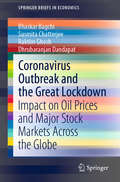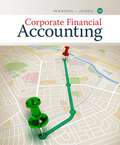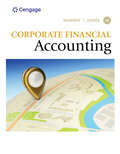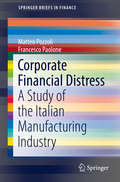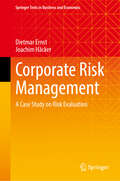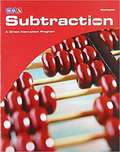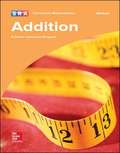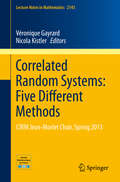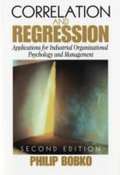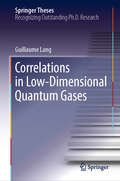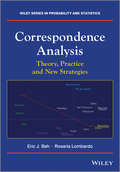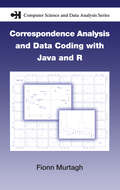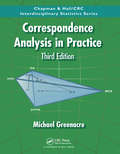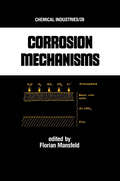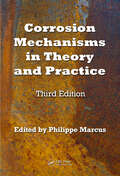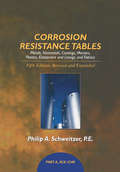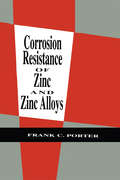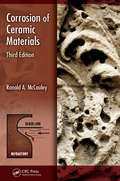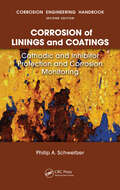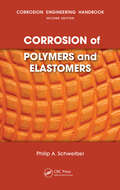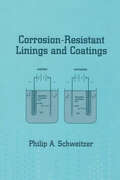- Table View
- List View
Corona: Eine Vignettenstudie (Palliative Care und Forschung)
by Martin W. Schnell Christine Dunger Christian Schulz-QuachDie in diesem Buch präsentierte Studie befasst sich mit der Frage, welcher Zusammenhang zwischen der Bereitschaft besteht, in der COVID‐19‐Pandemie anderen Menschen in deren Lebensvollzug zu helfen und der Furcht vor dem Tod durch COVID‐19. Das Buch gibt eine Antwort auf die Frage nach „Solidarität in der Krise“. Im Rahmen einer Vignettenstudie werden Einwohner*innen Deutschlands mittels Online‐Fragebogen zu soziodemographischen sowie situationsbezogenen Eigenschaften und ihren jeweiligen Vignettenurteilen befragt.
Coronavirus Outbreak and the Great Lockdown: Impact on Oil Prices and Major Stock Markets Across the Globe (SpringerBriefs in Economics)
by Bhaskar Bagchi Dhrubaranjan Dandapat Susmita Chatterjee Raktim GhoshThis book captures the dynamic relationship between COVID-19 pandemic, crude oil prices and major stock indices as well as the crude oil prices and stock market volatility that have been caused due to outbreak of this pandemic. The pandemic has changed the world melodramatically and major world markets collapsed in the beginning, affecting major industries in an unprecedented way. The book will be useful to the researcher in the field of finance and economics, and policy makers both at government and private level, keeping in view the present state of economy throughout the world.
Corporate Finance Version 2.1
by Stan EakinsWhen purchased from FlatWorld (the publisher), this Color Print Textbook includes Online Access, Quizzes, Flashcards and Homework (if professor uses Homework system). Online textbook is accessible. Corporate Finance is the first principles of finance textbook that was written specifically for delivery on an online platform. In this first edition published with FlatWorld, this book’s pioneering digital-first strategy has found a perfect home. The book encourages students to push beyond rote memorization of “how to do the math” to truly understand the meaning of the numbers.
Corporate Financial Accounting (MindTap Course List)
by Carl S. Warren Jefferson P. JonesGain a solid foundation in the core accounting concepts as you develop a true appreciation for why accounting is important to business and a prosperous society with Warren/Jones CORPORATE FINANCIAL ACCOUNTING, 15E. Available with CNOWv2, this latest edition clearly demonstrates how accounting is more than just data or black-and-white rules. Instead, you see how accounting provides key information that professionals use to make critical business decisions.
Corporate Financial Accounting (MindTap Course List)
by Carl S. Warren Jefferson P. JonesDiscover the importance of financial accounting in creating a successful business and prosperous society with Warren/Jones, CORPORATE FINANCIAL ACCOUNTING, 16E. This best-selling book clearly presents core financial accounting concepts within a meaningful business context, using engaging learning features that ensure a relevant, innovative learning experience. The authors demonstrate how accounting is more than just data or black-and-white rules. Updated content addresses the latest development and tools in corporate accounting today -- from using data analytics effectively to understanding the impact of discounts and sales in retail accounting. CNOWv2 online resources work with practice opportunities to ensure you understand and can apply key accounting principles. Prepare for immediate success on exams and advancements in your business career as you learn how to apply the key information that accounting provides to make critical business decisions.
Corporate Financial Distress: A Study of the Italian Manufacturing Industry (SpringerBriefs in Finance)
by Matteo Pozzoli Francesco PaoloneThis book explores methods and techniques to predict and eventually prevent financial distress in corporations. It analyzes the effects of the global financial crisis on Italian manufacturing companies and, more specifically, whether the crisis has increased the number of firms that are likely to fail. In the first chapter, the authors widely discuss the Corporate Financial Distress as well as the process and costs incurred. The second chapter is based on a review of the most used statistical models, splitting them into accounting-based and market-based models. The following chapter is dedicated to the methodology and the empirical analysis on Italian manufacturing companies from different industries. The last chapter presents practical evidence from Italian manufacturing companies during the recent financial crisis.
Corporate Risk Management: A Case Study on Risk Evaluation (Springer Texts in Business and Economics)
by Joachim Häcker Dietmar ErnstIn times of crisis, risk management is more important than ever. In addition, companies are obliged to identify, quantify and aggregate risks as part of a risk management system. Legal and auditing standards have set the framework for doing so. This book uses a case study to show ‘step by step’ how risks can be analyzed and quantified with the help of Microsoft Excel. The book begins with the graphical representation of risks and the calculation of risk parameters such as the value at risk. It subsequently aggregates different risks into an overall risk using Monte Carlo simulation. Hedging risks is also explained, and how non-hedgeable risks can be integrated into a business plan. The assessment of extreme risks is also addressed, as is the modeling of volatilities. The book is aimed at students of business administration with a focus on finance.
Corrective Mathematics Workbook Subtraction (Corrective Math)
by McGraw-Hill Education Editors Sra McGraw-HillWorkbooks include daily worksheets and point summary charts for recording student performance and awarding grades.
Corrective Mathematics: Addition Workbook
by Raymond Chang Sra Publications Staff McGraw-Hill Book Company Staff McGraw-Hill Education EditorsCorrective Mathematics teaches students the strategies they need for learning facts, working computation problems, and solving story problems. Corrective Mathematics' consistent and carefully sequenced lessons quickly bring students up to date on core skills, and each skill is taught so students fully understand it and practice it until it is mastered.
Correlated Random Systems: CIRM Jean-MorletChair, Spring 2013 (Lecture Notes in Mathematics #2143)
by Véronique Gayrard Nicola KistlerThis volume presents five different methods recently developed to tackle the large scale behavior of highly correlated random systems, such as spin glasses, random polymers, local times and loop soups and random matrices. These methods, presented in a series of lectures delivered within the Jean-Morlet initiative (Spring 2013), play a fundamental role in the current development of probability theory and statistical mechanics. The lectures were: Random Polymers by E. Bolthausen, Spontaneous Replica Symmetry Breaking and Interpolation Methods by F. Guerra, Derrida's Random Energy Models by N. Kistler, Isomorphism Theorems by J. Rosen and Spectral Properties of Wigner Matrices by B. Schlein. This book is the first in a co-edition between the Jean-Morlet Chair at CIRM and the Springer Lecture Notes in Mathematics which aims to collect together courses and lectures on cutting-edge subjects given during the term of the Jean-Morlet Chair, as well as new material produced in its wake. It is targeted at researchers, in particular PhD students and postdocs, working in probability theory and statistical physics.
Correlation and Regression: Applications For Industrial Organizational Psychology and Management (Second Edition)
by Philip Bobko"This book provides one of the clearest treatments of correlations and regression of any statistics book I have seen. . . . Bobko has achieved his objective of making the topics of correlation and regression accessible to students. . . . For someone looking for a very clearly written treatment of applied correlation and regression, this book would be an excellent choice. " --Paul E. Spector, University of South Florida "As a quantitative methods instructor, I have reviewed and used many statistical textbooks. This textbook and approach is one of the very best when it comes to user-friendliness, approachability, clarity, and practical utility. " --Steven G. Rogelberg, Bowling Green State University
Correlation in Engineering and the Applied Sciences: Applications in R (Synthesis Lectures on Mathematics & Statistics)
by Rajan ChattamvelliThis book focuses on correlation coefficients and its applications in applied science fields. The book begins by describing the historical development and various types of correlations. Rank correlation methods including Pearson’s, Spearman’s, and Kendall’s correlation are discussed at length. The book also discusses sampling distribution of correlation coefficients and applications of correlations in various fields. The book presents novel topics such as (i) a quick analytical method to approximate Pearson's correlation, (ii) single-variable correlation, (iii) fractional co-skewness and co-kurtosis, and (iv) the fallacy on correlation between the sample mean and sample variance. This book is ideal for courses on mathematical statistics, engineering statistics, and exploratory data analysis and is primarily aimed at upper-undergraduate and graduate level students. The book is also useful for researchers and professionals in various fields who are interested in data analysis.
Correlations in Low-Dimensional Quantum Gases (Springer Theses)
by Guillaume LangThe book addresses several aspects of thermodynamics and correlations in the strongly-interacting regime of one-dimensional bosons, a topic at the forefront of current theoretical and experimental studies. Strongly correlated systems of one-dimensional bosons have a long history of theoretical study. Their experimental realisation in ultracold atom experiments is the subject of current research, which took off in the early 2000s. Yet these experiments raise new theoretical questions, just begging to be answered. Correlation functions are readily available for experimental measurements. In this book, they are tackled by means of sophisticated theoretical methods developed in condensed matter physics and mathematical physics, such as bosonization, the Bethe Ansatz and conformal field theory. Readers are introduced to these techniques, which are subsequently used to investigate many-body static and dynamical correlation functions.
Correspondence Analysis
by Eric J. Beh Rosaria LombardoA comprehensive overview of the internationalisation of correspondence analysisCorrespondence Analysis: Theory, Practice and New Strategies examines the key issues of correspondence analysis, and discusses the new advances that have been made over the last 20 years.The main focus of this book is to provide a comprehensive discussion of some of the key technical and practical aspects of correspondence analysis, and to demonstrate how they may be put to use. Particular attention is given to the history and mathematical links of the developments made. These links include not just those major contributions made by researchers in Europe (which is where much of the attention surrounding correspondence analysis has focused) but also the important contributions made by researchers in other parts of the world. Key features include:A comprehensive international perspective on the key developments of correspondence analysis. Discussion of correspondence analysis for nominal and ordinal categorical data. Discussion of correspondence analysis of contingency tables with varying association structures (symmetric and non-symmetric relationship between two or more categorical variables). Extensive treatment of many of the members of the correspondence analysis family for two-way, three-way and multiple contingency tables. Correspondence Analysis offers a comprehensive and detailed overview of this topic which will be of value to academics, postgraduate students and researchers wanting a better understanding of correspondence analysis. Readers interested in the historical development, internationalisation and diverse applicability of correspondence analysis will also find much to enjoy in this book.
Correspondence Analysis and Data Coding with Java and R (Chapman & Hall/CRC Computer Science & Data Analysis)
by Fionn MurtaghDeveloped by Jean-Paul Benzerci more than 30 years ago, correspondence analysis as a framework for analyzing data quickly found widespread popularity in Europe. The topicality and importance of correspondence analysis continue, and with the tremendous computing power now available and new fields of application emerging, its significance is greater
Correspondence Analysis in Practice (Chapman & Hall/CRC Interdisciplinary Statistics)
by Michael GreenacreDrawing on the author’s 45 years of experience in multivariate analysis, Correspondence Analysis in Practice, Third Edition, shows how the versatile method of correspondence analysis (CA) can be used for data visualization in a wide variety of situations. CA and its variants, subset CA, multiple CA and joint CA, translate two-way and multi-way tables into more readable graphical forms — ideal for applications in the social, environmental and health sciences, as well as marketing, economics, linguistics, archaeology, and more. Michael Greenacre is Professor of Statistics at the Universitat Pompeu Fabra, Barcelona, Spain, where he teaches a course, amongst others, on Data Visualization. He has authored and co-edited nine books and 80 journal articles and book chapters, mostly on correspondence analysis, the latest being Visualization and Verbalization of Data in 2015. He has given short courses in fifteen countries to environmental scientists, sociologists, data scientists and marketing professionals, and has specialized in statistics in ecology and social science.
Corrosion Mechanisms (Chemical Industries Ser. #28)
by Florian B. MansfeldThis book discusses the mechanisms that have been proposed for the main corrosion phenomena, providing a thorough discussion of the pros and cons of the various corrosion mechanisms with support by experimental and theoretical results.
Corrosion Mechanisms in Theory and Practice (Corrosion Technology)
by Philippe MarcusUpdated to include recent results from intensive worldwide research efforts in materials science, surface science, and corrosion science, Corrosion Mechanisms in Theory and Practice, Third Edition explores the latest advances in corrosion and protection mechanisms. It presents a detailed account of the chemical and electrochemical surface reactions
Corrosion Resistance Tables: Part A (Corrosion Technology)
by Philip A. Schweitzer, P.E.Devoted to the latest research on mechanisms of corrosion and advancements in corrosion resistance, the updated fifth edition accounts for recent advances and offers a convenient, single-source tabular guide to materials used in the construction of all system components- from vessels to pumps to gaskets and packing- for processes and applications. Part A of 4 parts: Metals, Nonmetals, Coatings, Mortars, Plastics, Elastomers and Linings and Fabrics.
Corrosion Resistance of Zinc and Zinc Alloys (Corrosion Technology)
by Frank C. PorterA cornerstone reference in the field, this work analyzes available information on the corrosion resistance of zinc and its alloys both as solid materials and as coatings on steel, detailing the corrosion resistance of zinc in atmospheric, aqueous, underground and chemical environments. Corrosion Resistance of Zinc and Zinc Alloys illustrates the nu
Corrosion and Corrosion Protection Handbook: Cathodic And Inhibitor Protection And Corrosion Monitoring (Corrosion Technology #1)
by SchweitzerContinuing to provide excellent, state-of-the-art information on corrosion and practicalsolutions for reducing corrosion, the Second Edition contains valuable suggestionson how to select the best construction material for a specific application . . . choose anappropriate initial design to avoid inherent corrosion pitfalls . .. determine whatcorrosion problems may exist or develop, as well as the possible extent of the problems. .. and establish practices to monitor corrosion of existing equipment.In addition to significantly revising and expanding all chapters to reflect recent progressin the field, such as the development of materials for pollution control and methods ofcontrolling/preventing corrosion, Corrosion and Corrosion ProtectionHandbook, Second Edition features detailed discussions on such new topics asatmospheric corrosion, designing to prevent corrosion, sheet linings, and corrosioninhibitors.
Corrosion of Ceramic Materials (Corrosion Technology)
by Ronald A. McCauleyReflecting the many changes in the field since the publication of the second edition, Corrosion of Ceramic Materials, Third Edition incorporates more information on bioceramics, including nanomaterials, as well as the weathering of construction materials. Adhering to the original plan of classification by chemistry, this edition reorganizes the top
Corrosion of Linings & Coatings: Cathodic and Inhibitor Protection and Corrosion Monitoring
by P.E., Philip SchweitzerInstead of using expensive alloys to construct a tank or processing vessel, it is often more economical to use a less expensive metal, such as carbon steel, and install a lining to provide protection from corrosion. Corrosion of Linings and Coatings: Cathodic and Inhibitor Protection and Corrosion Monitoring offers focused coverage for professional
Corrosion of Polymers and Elastomers
by P.E., Philip SchweitzerCorrosion of Polymers and Elastomers provides a detailed examination of the corrosive effects of thermoplastic polymers, thermoset polymers, and elastomeric materials. The book is perfectly suited for specialists interested in the corrosion resistance and mechanisms of these materials. Following a general introduction to the composition, pr
Corrosion-Resistant Linings and Coatings
by P.E. SchweitzerThis book covers a variety of specific coatings and solid sheet and liquid applied linings, focusing on surface preparation, installation, and applicaton and detailing physical, mechanical, and overall corrosion resisitance. It compares and contrasts individual linings and coatings including glass, cement, various paints for concrete, and metallic

